The life of Goethe and his eternal work "Faust"
Johann Wolfgang Goethe was born on 28 August 1749 in Frankfurt, when it was a part of the Holy Roman Empire. His father, Caspar Goethe, is a legal advisor with the title Imperial Advisor. He personally takes care of the primary education of his son by teaching him music, painting and foreign languages. Goethe later studied law at the University of Leipzig (1765-1768). But he didn't like the legal sciences very much, and he prefers to attend regular theater, took drawing lessons, and made first poetic attempts. The poems written in Leipzig are in the spirit of the modern then elegant Rococo style poetry. In 1770, Goethe was awarded with "the Doctor of Law" degree and spent several months practicing in the court in the town of Wetzlar. Then he returned to his native Frankfurt.
.jpg)
Early creation of Goethe later inspired the next generation of German poets - Novalis, Nicolaus Lenau and others. The Sorrows of Young Werther and Götz von Berlihingen bring tremendous glory to their author. In the home of Goethe, there are many admirers, including the successor to the province of Saxony-Weimar-Eisenach Karl Augustus. As soon as he succeeds, he invites Goethe to live in Weimar and a seat in the State Council, then appointed as First Minister. He is enthusiastically involved in organizing Weimar's cultural life. Johan Gottfried Herder and Friedrich Schiller are working there. During this period, Goethe writes some of his finest ballads - Fisher, The King of the Woods, Singer, but in general, the great workload does not allow him full creative work. Some define it as a dying celebrity. Perhaps he himself was unhappy because in 1786 he secretly left Weimar and for two years he settled in Italy. The sentiment of harmonic antique culture had a huge positive influence on Goethe. He grew up in Germany wisely and reassured, filled with new creative plans. Fully oriented towards the principles of classicism, it is looking for opportunities for their recognition in contemporary German art. This is how the Weimar Classicism is born, inspired by the late Goethe's work, the magnificent Roman Elegies (1790), dedicated to his wife, Christine Vulpius; the epic poem Herman and Dorothea (1797); the dramaturgic works he began earlier, but only then rethought and published - Isphania in Taurus (1787), Egmont (1788), Torquato Tassos (1790); the model of the new educational novelist Wilhelm Meister - Years of Doctrine (1796) and Wilhelm Meister - Years of Wandering, as well as The Denial (1821), Memoir-autobiographical book Poetry and Truth (1811-1814) and many others. The Weimar Academic Edition of his works, commissioned by the great Duchess Sophie von Zaxen in the period 1887-1920, consisted of 143 volumes.
The glamorous age of his literary work Goethe ends with the greatest work of his life, the Faust tragedy. He defines it as an undisputed leader in the intellectual life of Germany. Even Napoleon, in 1806, after conquering the town of Weimar, spent an hour devout talking to Goethe and rewarding the Cross of the Legion of Honor. Son of one of the most stormy and controversial epochs of German history, Goethe's long life coincides entirely with the second half of the enlightening 18th century and the first third of the 19th century when capitalism quickly settled in Europe, including the homeland of the writer . Young Goethe, who became a spiritual guide and symbol of the pre-romantic direction Storm and Stream (60-80s of the 18th century) in his youth, is a contemporary of the French Enlighteners-encyclopedists Volter, Diderot, Rousseau. The ideas of the Storm and Storm movement have a great impact on Goethe's early work. The main topics in it are the strong personality, the genius, the superman. Among his most famous works of this period are the Prometheum (1774), the original version of Faust, the first German historical drama Götz von Berlihingen with the iron hand (written in 1771 and published in 1773) and the sentimental novel The Sorrows of Young Werther (1774).
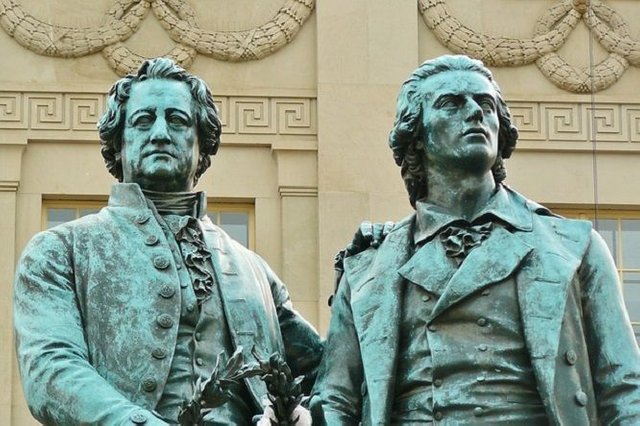
Weimar. Goethe and Schiller
He also witnessed the pre-revolutionary boiling in neighboring France and the burst in 1789. there was a bourgeois revolution, but as an observer of the memorable battle at Valmi between the French Revolutionary Army and the armies of counterrevolution and their helpers in 1792, he expressed the thought that he was present at the birth of a new historical age. In his adult age, Goethe witnessed the Napoleonic wars, redefined the map of Europe and had an enormous impact on the political and spiritual life of Germany at the time. at the invitation of Emperor Napoleon Goethe meets with him in Erfurt. A testimony of Goethe's unshakable human and writer's dignity is his response to Napoleon's suggestion that he could devote his work to the Russian Emperor Alexander I, who is also in Erfurt I did not have such a habit, when I began to write, I accepted the principle of not initiating initiations to never repent. And when the emperor noted that the great writers of the age of Louis XIV did not do so, Goethe says: It is true, but Va Majesty is not claimed that they have never regretted. Goethe survives not only the Napoleonic wars, but also the Restoration, and the Julian Revolution of 1830, made with vicissitudes (especially for his native country).
Meanwhile, his home in Weimar has become the capital of the spirit that people seek for word and thought from all over the world. Goethe does not miss the pen for the rest of his life and keeps an eye on the young literature. When on March 22, 1832, The 82-year-old Goethe died, he left 40 volumes of works published under his personal supervision by the famous Geothe publisher. Later on, he added his unreleased works, his scientific writings and his voluminous correspondence, thus bringing his collected works the impressive figure of a hundred volumes. Goethe's work makes an impression not only on its volume but also on its variety. It is hard to say that a poet or beleaguer is a writer. Poetry Goethe writes from his teenage years almost to the end of his life, creating thousands of poems in a variety of lyrical genres of ballads, elixirs, sonnets, epigrams, philosophical poetry. Goethe's poems are one of the highest peaks to which he is In the midst of the Storm, the poetry fragments Prometheus, Mohammed, and many of his lovely lyrical songs and ballads have been attributed to the period of Storm and Muhammad. In his adult age, Goethe is interested in Persian classical poetry, reads Hafes and writes his famous West- a genius interpretation of the enthusiastic motives of the East. And if such poetic masterpieces such as Wedding Song, Pygmalion, Temenujka, Gypsy Song, Stranger Story, etc., were written at the beginning of Goethe's creative path, the famous Elegy entered the literature such as Marienbad, is one of his last powerful lyrical outbursts brought about by the love of the adult poet to the twelve-year-old Ulrike von Levetzov. The epic poem Herman and Dorothea (1797) written in hexameters is the result of the enthusiasm of Goethe in the Ancient World and Homer the epic.
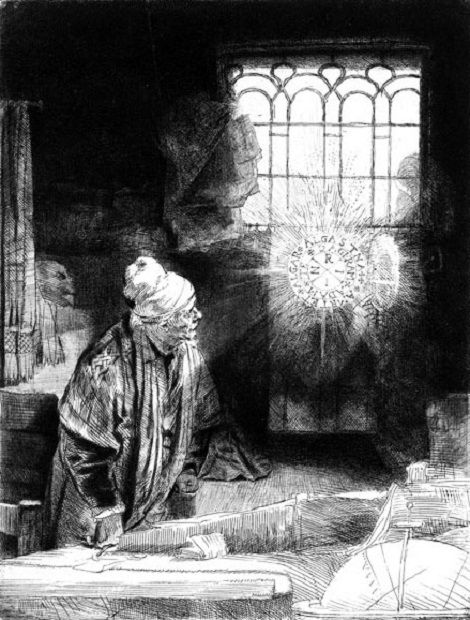
Faust in His Studio, Rembrandt Harmensz van Rijn
Goethe is also a brilliant playwright. In his youth, when he is one of the inspirations of the literary movement Storm and Shooter, he is drawn to Shakespeare and writes in the spirit of his chronicle Göts von Berlihingen, a plot of the German war in Germany (at the beginning of the 16th century). Goethe later embraced the Roman classics and created for the Weimar Theater, whose mentor and artistic leader for several decades, the plays Iphigenia in Taurus, Egmont, Keyvig, Torquato Tassos and the Illegal daughter, who are an important place in the development of the German classical theater. Göte shares his great friend Schiller's view of the theater as a public institution and artistic phenomenon. A prominent role for the important role it plays as a tribune for debating the most important public ideas is the famous Prologue in the theater to the Faust tragedy. With several novels, Goethe stands out as one of the builders of the German novel. World fame brings to the young writer his first novel The Sorrows of Young Werther (1774), written in the form of a diary of a real experience. The novel Wilhelm Meister is similar to the tragedy Faust that he had matured in Goethe's mind for several decades. The first version of the novel dates back to 1777. With Wilhelm Meister Goethe marks the beginning of the so-called edutainment novel in German literature, which depicts the moral maturation of the hero . Intense by design is also the novel Rodents of choice. Goethe leaves a lasting trace in German autobiographical prose with his book Poetry and Truth (1811-1833). Finally, he is also a remarkable aesthetician, a theorist and art critic who responded with rare benevolence and a remarkable skill of the most - the major events in the spiritual life of its era. This relatively poorly appreciated by its contemporaries activity today stands out in the perspective of time as yet another bright feature of his all-round creative genius. Faust is a small creative universe. For the impact on world art and literature, we judge not only the translation of foreign languages but also the numerous interpretations of the subject in poetry, drama, novelism and music of the peoples. While Goethe himself takes on the theme of the legendary magician and magician Dr. Faust of the folkloric books and developed before by remarkable artists such as Marlowe and Lessing, it is only in his interpretation that he acquires all-human dimensions.
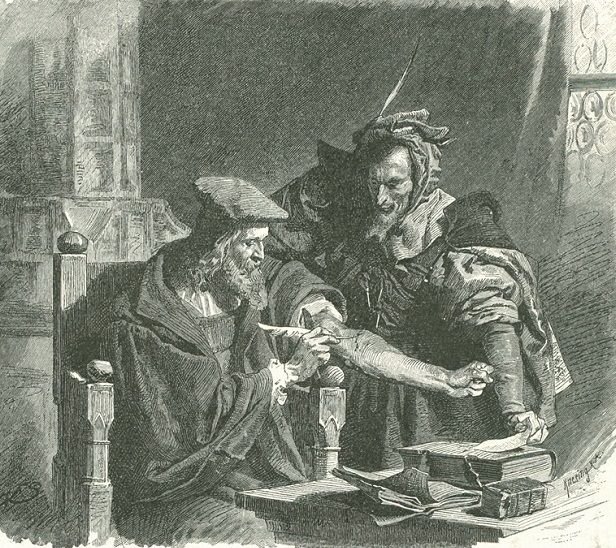
Teufelspakt
Goethe has worked Faust throughout his conscious life as a writer. From the original design to the final version, it is about 60 years old. The first version, which contains most scenes from the first part, was written around 1773-75, ie. before the Goethe became a personal adviser to the Weimar Duke. The writer destroyed this option later in Weimar, but a copy of it was kept in the archives of a lady in the courtyard and was printed in 1886 when they were discovered. The comparison between this early, known in the literary science as Prafaust, and the final version, gives an opportunity to judge the development and maturation of the creative concept. For a decade, Goethe abandoned his work on Faust. His admission to Italy (1786-1788) and his admiration of the classical antiquity brought him to write two new scenes, and in 1790, the writer prints a large fragment of the first part. Especially fruitful is the last decade of the 18th century, when Goethe is encouraged by his friend Schiller, who closely follows his work on Faust. The first part was printed only after Schiller's death in 1808. After a new interruption, Goethe resumed his work in the second half of the 18th century when he published a fragment from Elena, called Elena. Classic-romantic fantasmagoria 1827). The second part was finally completed in the summer of 1831, just months before the writer's death, and was first published by posthumously in 1832. In the six decades, when Goethe made his Faust, the world underwent immense changes, and along with him the writer changed. The work reflected the creative and spiritual evolution of Goethe himself. In this sense, Faust was his most cherished work.
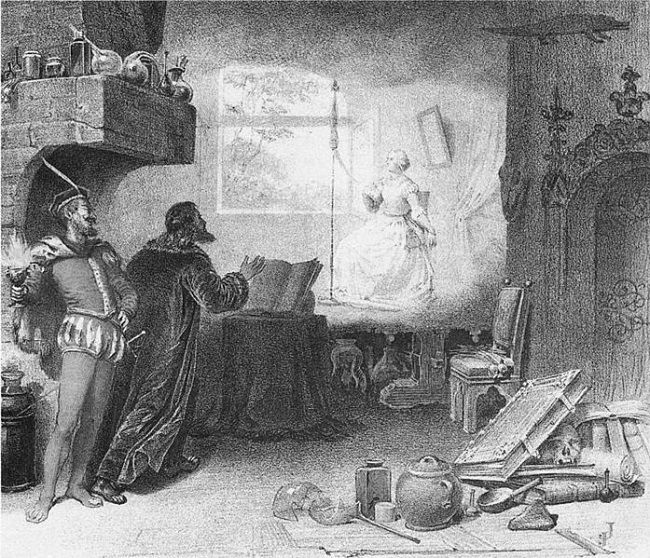
Faust by Gounod Act1 1864 Covent Garden
Determining his work as a tragedy, Goethe was not too concerned about the purity of the genre qualifications. Over time, it has expanded too much in volume, and in the final version it numbers 12111 verses. This makes the tragedy difficult to place on stage. 19th century, several productions have been made, none of which can be considered as a certain success. The most popular stage adaptation is the popular opera of the French composer Charles Gouno Faust (1859), based on the motifs of the first part of the tragedy. According to German literary critics, Faust is a reading drama. Although this definition has not been disseminated in the theory of literature, it conforms to the peculiarities of the work and is accepted in the German-speaking countries. In his Storm Years of Storm and Pressure, Goethe writes fragments of dramas about Prometheus and Mohammed but abandons them because his creative imagination is fascinated by Dr. Faust's image of the German folk tradition. He also read in his childhood one of the last published a book of Doctor Faust's National Book and watched puppet shows for him in his hometown of Frankfurt am Main. In his youth, the subject of the daring alchemist and sorcerer who sold his soul to the devil attracted him with the challenge of man to strike across man's boundaries Eshkol knowledge and stepped raw foreclosures church.
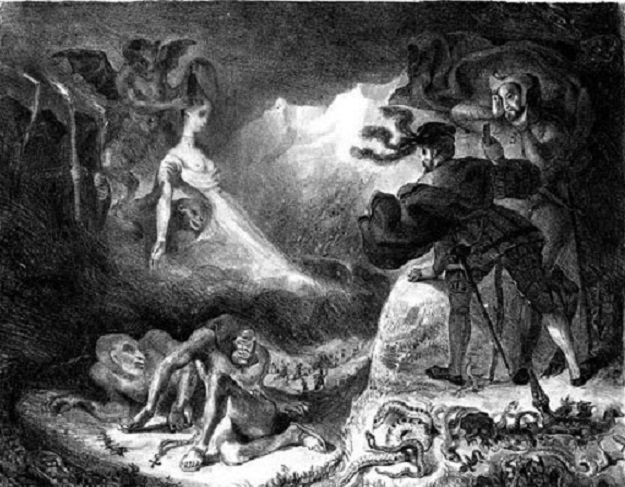
Marguerite's Apparition Appearing to Faust
Faust is an extremely elaborate work, in which several ideological and philosophical layers are superimposed. In the first part, Goethe carries the action into the era of the historical Dr. Faust, at the beginning of the 16th century, the end of the German Middle Ages. In the second part his character acts on the vast scene of history, and the action takes place in different historical eras - Greek antiquity, the German Middle Ages, until the beginning of the 19th century, when Goethe finishes his work. Quite naturally his character grows beyond the limited features of the legendary his prototype, becomes super-human, a representative of the whole human race and his aspirations. The Great Pushkin, to whom Goethe symbolically transmits his pen, is so inspired by his Faust that he exclaims: "This Goethe work will remain the greatest creation of the poetic spirit, the embodiment of modern poetry, as Iliad has become a monument to classical antiquity. These words, spoken shortly after the second part of Faust, are confirmed in the perspective of time. Faust really ranks among the masterpieces of human thought and spirit.
Art and its history, thank you for filling us with culture
You are welcome :)
Faust is an excellent piece! One of the most famous pieces where the main character sells his soul to the devil. Thanks for sharing!
Yes. read Doctor Faustus by Thomas Mann too :)